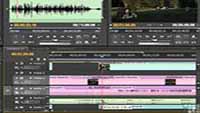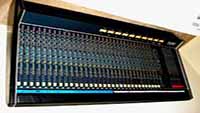 Mixing and mastering is a complex process. Consequently, it consists of several steps like any other similar process. If you consider mastering in general and in theory, it consists of only 3 steps: editing, processing and transferring recorded audio in a necessary format. In practice, mastering consists of much more steps. This article refers to 12 out of them.
Mixing and mastering is a complex process. Consequently, it consists of several steps like any other similar process. If you consider mastering in general and in theory, it consists of only 3 steps: editing, processing and transferring recorded audio in a necessary format. In practice, mastering consists of much more steps. This article refers to 12 out of them.
1. Audio Analysis
Before you start mastering, you should thoroughly analyze the audio to estimate its quality, to discover different flaws and if possible to eliminate them. There can be such main flaws in the audio as impulse interferences, noises, pickups, hum and different distortions of the signal.
2. Editing
Editing is performed after the analysis of a track in case there aren’t any technical flaws in it. Editing is not a compulsory procedure. However, it is often needed, for example, to copy a part or to eliminate excessive pauses at the beginning and at the end of the audio. Editing is necessary in this case.
3. Level Normalization
Normalization is a process which changes the signal in such a way that its loudest peak reaches the target level. Similar to the case with editing, the question about the necessity of normalization remains disputable. If the peak level of the audio is too low, normalization will help to correct this situation. Meanwhile normalization raises an overall level of the audio and along with it accordingly all its noises. If the audio has been normalized to 0 dB, it will be distorted to a greater extent during further processing.
Please also check my mastering prices.
 4. Limiting
4. Limiting
The main goal of limiting in mid side mixing is the prevention of signal clipping. In case the audio has been normalized to 0 dB, processing level will increase. After the processing the signal level will inevitably rise as well. It will bring on some overload. By including a limiter into the chain at the initial stage of processing you will prevent the audio from it.
5. Filtering
The range of frequencies heard by humans is from 20 to 20 000 Hz. In spite of it, there can be such sounds in any audio that go beyond it, especially at low frequencies. As a rule, they are non-music sounds: interferences, pickups etc. The presence of such interferences can later have a negative impact on an overall level of sound. Low frequency interferences only load up loudspeakers. It often causes their rapid wear. The noises which go beyond the range of the initially recorded signal can interfere with its perception. Therefore mastering engineers often use filtering to eliminate frequencies below 20–40 Hz and above 18–20 kHz.
6. Equalization
Equalization is one of the most significant and responsible steps of music mastering. This process involves audio processing via an equalizer and implies correction of the amplitude and alteration of the frequency balance. Equalization is used quite often and is conditionally divided into two kinds: aesthetic and technical. The target of technical equalization is to reach a precise tonal balance. Aesthetic equalization makes sound more saturated, vivid and clear.
While working, mastering engineers use two kinds of equalizers: graphic and parametric. Graphic equalizers usually have 31 bands for each channel and are often equipped with spectrum analyzers. It turns them into more convenient devices. At the same time parametric equalizers give more opportunities to correct frequency response as each band of this equalizer has at least three adjustable parameters. It allows engineers to choose the necessary frequency more precisely and to adjust it more accurately.
 7. Compression
7. Compression
Compression in mastering is quite an important step which is used for making the audio dense and for enhancing its perceived loudness by means of narrowing the dynamic range. When mastering, mixing distorted guitars use both single-band and multi-band compressors, but often with additional specific functions. For example, compressors with automatic adjustment of the attack time and release are often used. It guarantees dense but at the same time musical compression without any audible alterations, distortions and other side effects.
8. Stereo-Base Widening
The sense of this process is in enhancement of stereo effect. After stereo-base widening the sound becomes wider and more binaural. Stereo-base widening is used in case the emphasis is laid not on density, but on sound capacity. Mastering is a war of compromises, accordingly, when capacity is added to the audio via stereo-base widening, it causes simultaneous dropping of its density. It makes a mastering engineer look for a compromise. In the meantime this effect can work in the opposite way. It can reduce the difference between channels improving their phase compatibility in this way. Consequently, thanks to this effect in many cases it is possible to “rescue” audio with bad mono-compatibility.
9. Exciter’s Processing
An exciter is a device that simulates saturation effect in tubes, in consequence of which harmonics that sound pleasant to the ear are added to the signal. An exciter is used in music mastering to give the audio vividness and crystal clarity. When the exciter is on, the sound becomes more distinct and clear due to enhancement of high frequencies. But unlike an equalizer the exciter doesn’t enhance frequencies, it creates new harmonics. Exactly because of that the device belongs to psychoacoustic processing. The use of an exciter in mastering is limited as it can both improve and damage the audio by turning its sound into excessively sharp and piercing.
 10. Loudness Maximizer
10. Loudness Maximizer
One of the basic aims of music mastering services online is to reach quite high perceived loudness of the audio. When compression and normalization are used, the loudness of the audio usually grows up noticeably. But if one of commercial records of a similar style is on, we realize that we still greatly lose loudness to it. In this case maximizing is used and it is mainly performed with the help of a device called a maximizer. At the same time rarely can maximizing only via a maximizer be sufficient. It can be reached by means of precise volume grading and some other devices of dynamic processing.
11. Dithering
Dithering is adding low-level noise to the signal before the reduction of its bit depth. The reduction of bit depth of the signal during recording, for example, a 24-bit audio on CD or during its simple conversion into a file with lower bit depth can cause distortion of sound. Some excessive harmonics and other problems can turn up at a low level of the signal. You should use dithering to solve these problems. With the help of dithering you can eliminate all distortions and replace them for constant noise practically undistinguished by ear.
12. CD recording
CD recording is a final step of mastering when ready-made audios are recorded on a master disc from which matrix for copying will be manufactures at a plant. As for album mastering, this step will also include a lot of procedures: making a sequence of tracks, setting the time of pauses between them, creating smooth fading of sound at the end of the audio and there where it’s necessary and so on.
If you need professionall engineer for your music - please learn my music.
